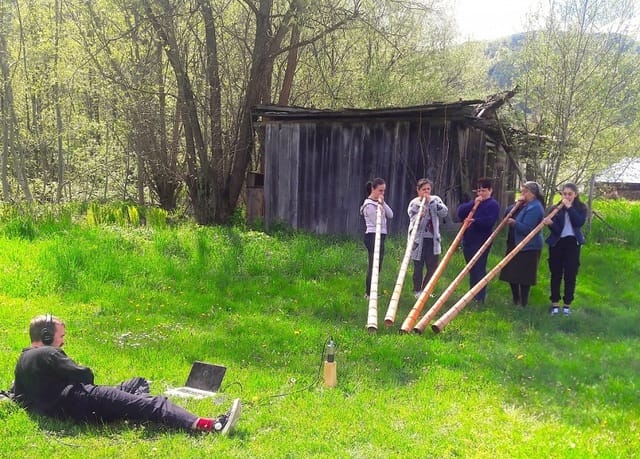Register for free to receive our newsletter, and upgrade if you want to support our work.
A cultural particularity related to this instrument is that, predominantly in the Apuseni region, only women play the tulnic. Another particularity is related to its materiality: its length, thickness, weight, type of wood, the various manufacturing processes it undergoes, the way and space in which it is stored (temperature, humidity, exposure to sunlight), the frequency with which it is used – all these elements constitute an index of the instrument's uniqueness regarding its sound capabilities and ways of usage.
In 2019 I participated as a curator in realising a cultural project within the Europalia Arts festival in Belgium, which dedicated its 27th edition to Romania. The project presented by The Attic had three stages: the establishment of an ensemble of tulnic players (women and girls who play the tulnic) of various ages, resulting from a ten-day residency in the commune of Avram Iancu (Alba County); the creation by Milan Warmoeskerken of an experimental, electronic composition that includes traditional tulnic performances; and the production of two concerts by the ensemble in Belgium, in the cities of Brussels and Leuven.
An archaic tool of communication and musical woodwind instrument
The tulnic has a tubular shape, open at both ends; to produce sound, one blows into the narrower end. “The sound principle of the bucium is the same as that used in brass instruments (trumpets). It emits a fundamental sound and (depending on the type of instrument) an unspecified number of upper harmonics,” notes Romanian ethnomusicologist Ovidiu Papană.
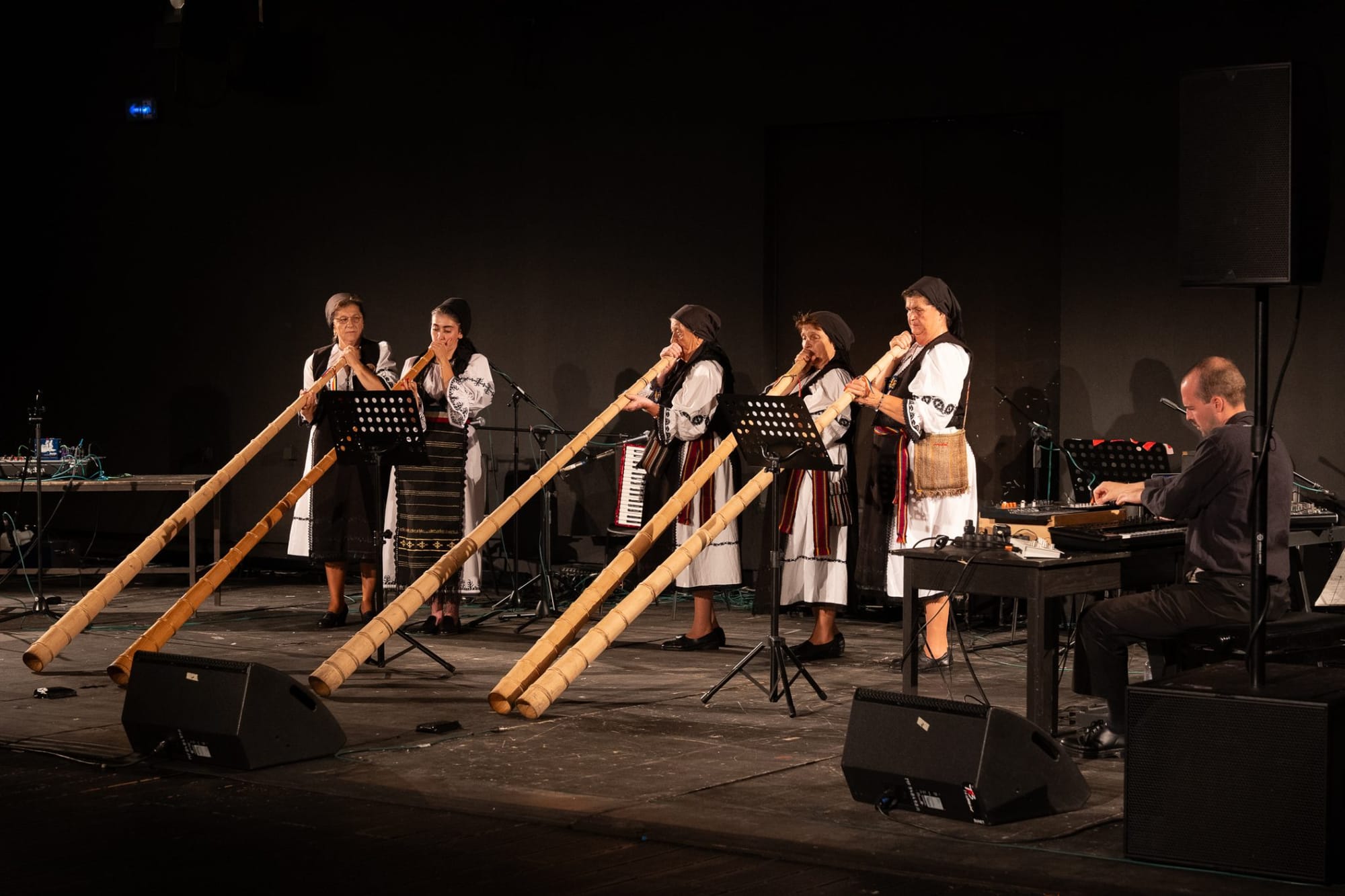
The tulnic has a structure similar to the Swiss alpenhorn– an instrument that has undergone structural and usage modifications over time, due to tourism. Unlike the alpenhorn, no musical compositions or notations have been written to support the tulnic as a musical instrument. The music of the tulnic has remained historically rooted in oral traditions. As an instrument, it has several distinct characteristics: long dimensions, from 2.5 to 3 meters, a specific type of wood used for its manufacture, and straight ends. Several factors can influence both the quality and quantity of the musical notes produced: the way the tulnic is made must fully align with the user’s abilities to play it. From my own experience, playing the tulnic is not necessarily easy. Since it is a wind instrument, it requires specific positioning of the lips at the narrower end and carefully controlled breathing, as it is difficult to blow continuously for more than half a minute.
The tulnic dates to ancient times, and its origin is difficult to determine. The American musical archaeologist Bo Lawergren notes that the oldest musical instruments originated from a common source: hunting tools. Noisy instruments (percussion, trumpets, or bucium) were used to call or scare away prey and to signal between hunters. Thus, the tulnic was historically used as a communication instrument among mountain inhabitants, for guiding livestock or alerting the community to various events: the presence of wild animals near human settlements, battles, ecological dangers (fires or floods), or gatherings.
Not all craftsmen are equally skilled in making tulnics that can produce the desired sounds; a high-performance tulnic depends, first and foremost, on the choice of wood. The best is the wood of “fulgeriş,” meaning the spruce that grows on rocks, away from water sources. When a craftsman strikes the wood with the back of an axe to check its vibration, the trunk must have a prolonged resonance with a high vibration, the tree must have few knots, and a height of at least 4 meters, as the first 50 cm from the root upwards cannot be used; if the trunk is too thick when split, this part cracks unevenly and is difficult to hollow out.
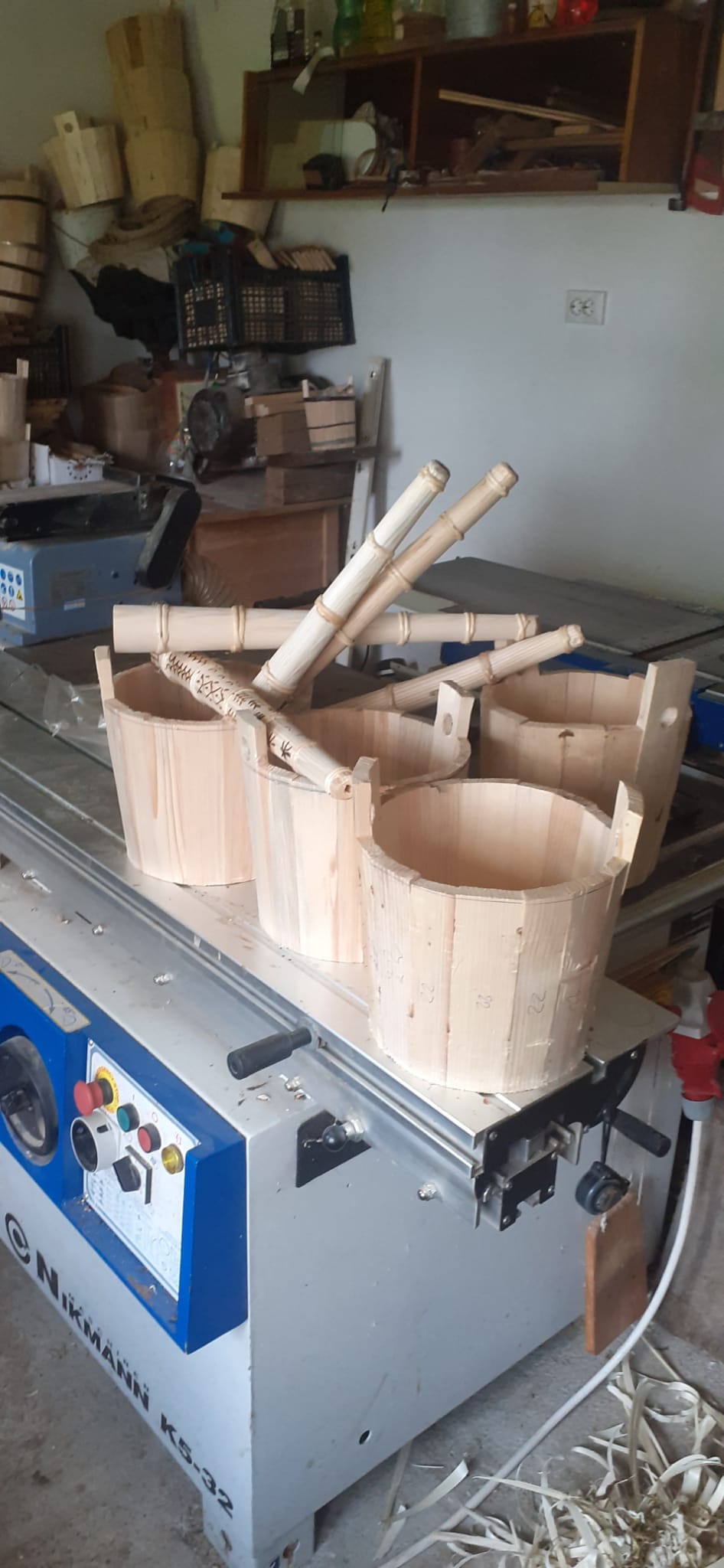
“The tulnic should not be exposed to the sun,” Mircea, a craftsman from Arieșeni (a village in Apuseni mountains) who makes tulnics, tells me as he begins to work on a small tulnic to show me the process. A tulnic is made in stages, over several days. First, the tulnic is hollowed out, then left to dry for about a week, and then hollowed out again for finishing. The hollowing process is important because the walls must be of equal thickness across the instrument’s entire surface. The next stage involves glueing the two parts of the tulnic, which result from splitting and hollowing, and then the rings are placed on the tulnic. These rings are made from green juniper branches, which offer flexibility. The decoration of a tulnic used to be done with a hot iron engraver (some chisels made by blacksmiths), applying various floral shapes on the walls of the instrument: fir trees, saw teeth. Nowadays, this process is done with special pyrography tools. Afterwards, the tulnic is sanded and finished on the rough parts, and to make it more durable, and for aesthetic reasons, it is varnished. Finally, the tulnic is soaked on the inside in hot whey to close its pores; this process is recommended to be done two or more times for a clearer sound.
None of the craftsmen I spoke with knows how to play the tulnic. They can make it produce sounds, but they do not know how to perform music and are not interested, as they consider this activity reserved for women, the tulnic players. Thus, to “tune” the instrument, the craftsmen call on professional tulnic players. These women are also the ones who buy most of the tulnics. Nowadays, young people are no longer interested in this instrument, and craftsmen believe that the tulnic “has already died or is on its way out.” “The youth go somewhere to make a better living than here, where they can’t do anything,” Nicu Beleiu Tudoraș, a tulnic craftsman, tells me. In Avram Iancu, only three craftsmen remain out of the 20 that once were. He learned the craft from his father (who in turn learned from his parents), indicating that the art of barrel-making (an activity reserved exclusively for men) is very old and is passed down orally, from one generation to the next. He believes that the tulnic is now just a museum piece, due to the lack of involvement from the authorities in preserving this culture.
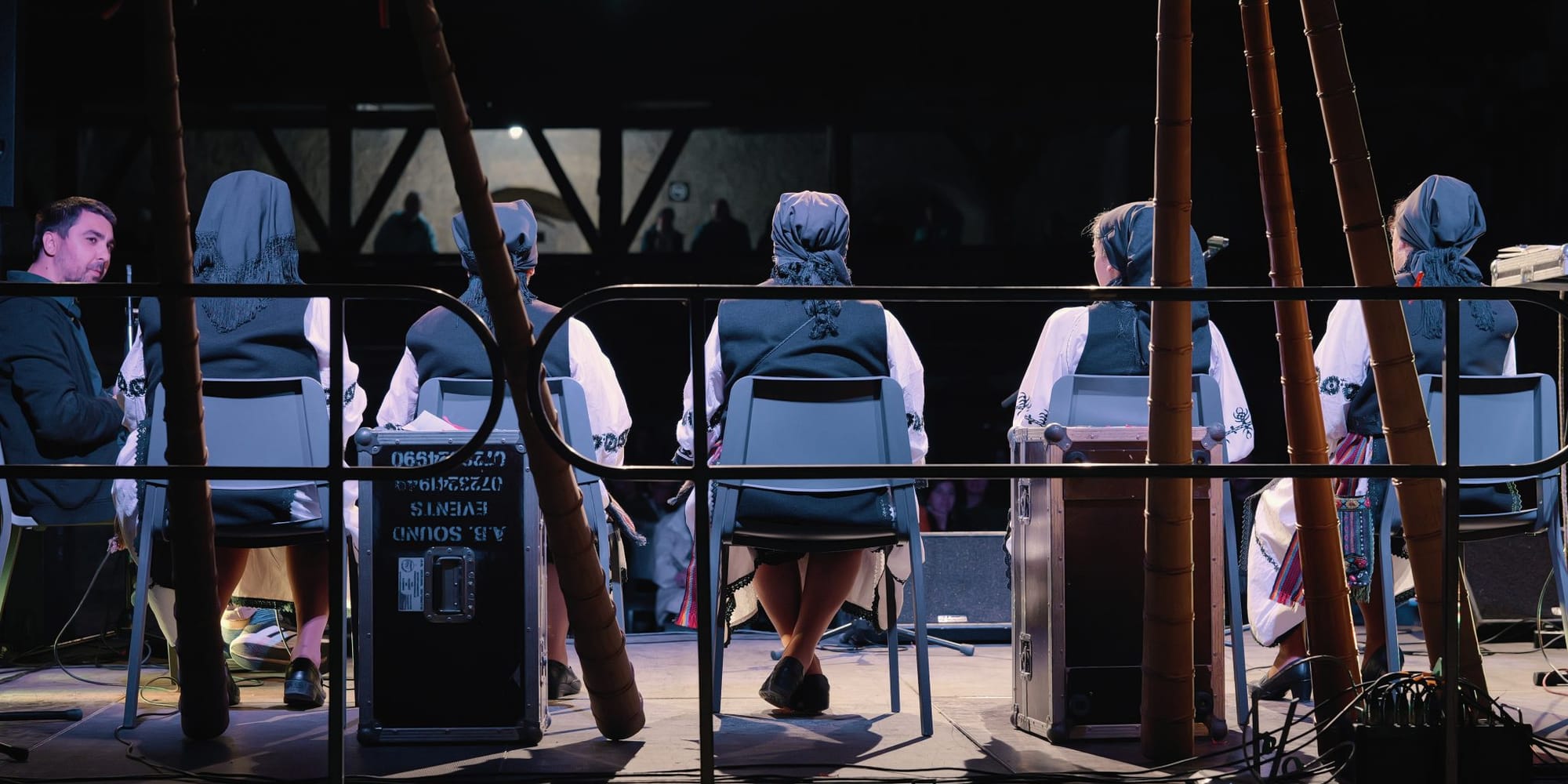
The repertoire of the tulnic
During the documentation period, the first tulnic recordings I found were from the American ethnomusicologist Alan Lomax, who curated a 1960 compilation entitled World Library of Folk and Primitive Music: Romania(with notes written by Romanian ethnomusicologists Speranța Rădulescu and Tiberiu Alexandru). The compilation contains traditional Romanian folk songs and tulnic recordings, such as Spring Signal, performed by Iosana Bud. These recordings were made between 1934 and 1957 by several Romanian ethnomusicologists and composers, including Constantin Brăiloiu and his student and collaborator Tiberiu Alexandru, and they attracted the attention of the American record label Ethnic Folkways (a sub-label of Smithsonian Folkways), which released several compilations dedicated to Romanian folk songs and dances (such as Rumanian Songs And Dances). In most cases, the music on these international compilations was taken from recordings made at the Constantin Brăiloiu Institute of Ethnography and Folklore in Bucharest.
In the tulnic culture, several short songs have been learned, adopted, and passed down orally from generation to generation. Most of the songs are under half a minute long and consist mainly of rhythmic, repetitive tones, with cadences and variations differing from one performer to another, either due to personal choices or because of the instrument or the player’s abilities. Among the most well-known songs and calls are Șipotul, Cântecul Iancului (or Iancu’s Call), Call from Mount Găina, Drăguțu’s Call, Citereana, Cattle Call to the Mountain, Spring Calls, Forest Roar, Bulzăneasca, as well as other calls or signals prompted by community or family events. The sounds of the tulnic announced important events in village life: the call to a wedding, a communal work event, a spinning party (a social gathering during the long winter evenings), or the cattle’s ascent to the mountain at the beginning of summer. The woman or girl would call her beloved (the fiancé) in the evening. When a cow got lost from its herd in the forest, it was called back through the tulnic, as the animal recognized the sound and returned to the hut.
These songs have multiple meanings and interpretations, varying from the repertoire of tulnic players from various regions in the Apuseni mountains. No one knows precisely when these songs, calls, or signals that make up the tulnic’s repertoire first appeared. They are part of the oral tradition and are attributed to a distant, imagined past that lingers in collective consciousness. In the history of the tulnic, there was a period of transformation of its utility from a simple communication tool to a musical instrument.
Village life in Apuseni mountains
The villages from Apuseni mountains offer the opportunity for each inhabitant to contribute to the collective social display, leaving their imprint on the aesthetic of the community. The household is an extension of the social self of each villager. From how the fence looks, what material was used for its construction, what colour was chosen, to how the roof looks, how many layers it has, and what kind of materials were used (old or new tiles, shingles, scales, straw, or metal sheets), the appearance of the windows, the colours used to decorate the house, what kind of car exists or not, what barn each household has, and what domestic birds or animals each resident owns.

From my fieldwork, I learned that “in the old days” (referring to the communist period in Romania) every house in the village had a tulnic. When invoking memories, the elderly differentiate between then and now, suggesting their personal experience of living through two different political regimes: the communist regime and the post-communist, capitalist one. The transition from one political regime to another brought radical changes to the lives of the inhabitants of the Apuseni Mountains. The shortages of the communist period (food, clothing, footwear, transport infrastructures, and technological tools to ease various activities) transformed into capitalist abundance, but the reverse of this process is the current lack of sufficient financial resources to access that abundance. The birth rate has declined, and the large families of yesteryears have diminished. During my walks through the commune, I observed abandoned houses, some for sale, or deserted, while others were recently built. The mining operations for natural resources (uranium, coal, gold) were closed after 1989. The new democracy, which opened the borders to the West, prompted the younger rural population to migrate to urban areas or try their luck in Western countries.

Because there was no electricity in the commune until the 1970s, the tulnic was considered an indispensable communication tool between houses and hamlets in the valleys and slopes of the mountains, an object as important in its utility as the mobile phone is today. Artisan craftsmen (barrel makers) who mastered the art of wood decoration through carving, engraving, and pyrography, annually crafted barrels for storing brandy or wine, as well as hundreds of tulnics, which they later sold at the Găina Mountain fair or various other fairs across the country. Today, very few craftsmen remain in the Apuseni Mountains. For barrels, wood has been replaced by plastic, and the barrel-making craft has lost its economic potential. Similarly, from a communication tool between locals, the tulnic transformed itself into a musical instrument, whose repertoire contributed to the Romanian folkloric area and the effervescence of nationalist spirit, ultimately reaching the status of a handcrafted object today.
The communities of tulnic women from Apuseni mountains
In the commune of Avram Iancu, the institutionalization of the instrument began in 1960 when teacher Elena Pogan founded the first group of female tulnic players in the country. Thus, she chose the best tulnic players (among girls and married women, young) with whom she began rehearsals twice a week. The tulnic group founded by Miss Pogan (as she was called in the commune since she was never married) initially included six members, and soon the group grew to 20 tulnic players. During this period, the group participated in performances, folk festivals, fairs, and events across the country, including in Bucharest. Although initially composed only of women, over time the group included the only man who played the tulnic, Mihai Duma. In 1992, due to health reasons, Elena Pogan retired and passed on the responsibility of leading the group to her successor, Mihai Duma. Elena Pogan passed away in 2010, and Mihai Duma five years later. I found the graves of both in the cemetery of the church in the village of Avram Iancu.
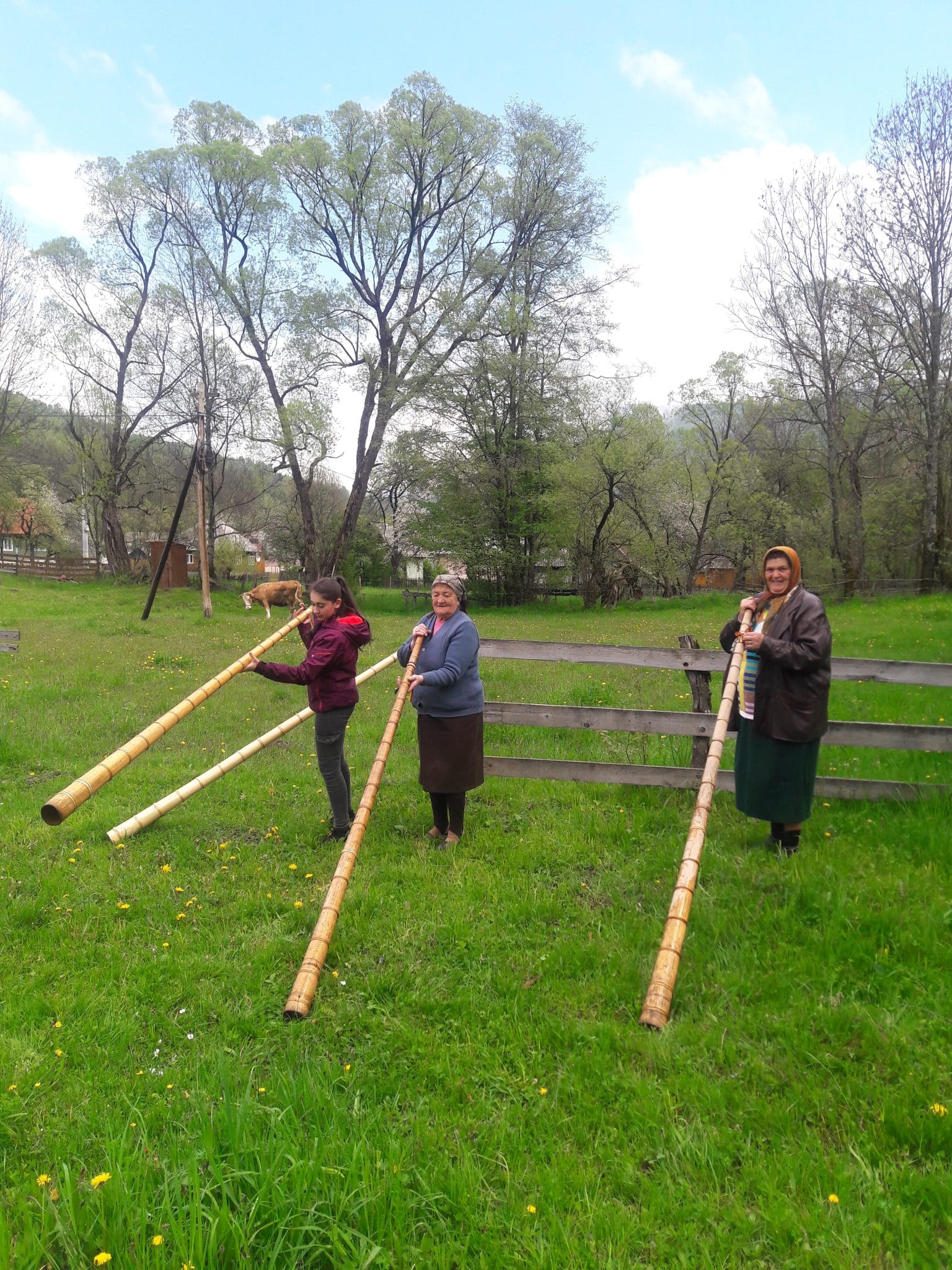
All the female tulnic players speak about Mihai Duma with admiration and respect. They consider him the most professional and talented tulnic player “of all time” and say that there was no woman in the village who could play the tulnic as well as he did. “He was lively, reliable, and kind-hearted.” Mihai Duma didn’t just play the tulnic; he also played the flute and the tárogató. He was also never married and had a very close relationship with his animals (sheep, chickens, cows, dogs, pigs, cats), with whom he lived in the same house. Maria Coroiu tells me that Mihai Duma “would come and buy products from the grocery store, and when I asked him, Mihai, why are you buying so much bread? he would reply, ‘There are many mouths to feed at home.'” I learned that his last wish was to be buried with his tulnic beside him and to have the women play at his funeral. When he passed away, his wish was honoured, and his tulnic was placed beside his coffin. However, since it was too long, it was cut in half to fit into the grave.
Maria Coroiu tells me that among men, only Mihai Duma chose to play the tulnic, as men typically pursued other things. “They had other trades; they didn’t learn to play or need the tulnic. I remember some boys from the local school wanted to learn to play the tulnic; they started to play until one day, other classmates came and said, ‘What, are you going to play the tulnic? What, are you women? Or do you think you’re Mihai Duma?’ And that was it; they never touched the tulnic again, they didn’t want to.” She highlights that the tulnic is an instrument meant for women.
For women, playing the tulnic is both a profession, a social distinction within the community, a passion, and a therapeutic activity. Men would travel around the country to sell wooden tubs, while women stayed home to care for the household and family, assuming their predetermined role as mothers, the first and most important role. Lenuța Fiț, another tulnic player from the studied community in Avram Iancu, tells me she travelled to many places with the group of tulnic players, but after giving birth, she took a break, as she had no one to leave her children with. “I had to stay home to take care of the children, the household, and the animals. My husband also had a job.” But after the children grew up, she resumed performing with the group.
Titiana Drăgoi, another tulnic player in the group and my generous host, told me that the tulnic can’t be played using musical notes. “The stave doesn’t listen to you, sometimes it seems to blow how it wants. Even if you want to hit a high note, it might play a low one instead. It takes three or four years to learn a tune on the tulnic. I’ve noticed that the tulnic plays in a certain way. For example, I can’t play on Mărioara’s or Jeni’s tulnic, and they can’t play on mine. Each tulnic has its power. For young girls, the tulnics are about a meter long, and as they grow, they can play longer tulnics.” She tells me that tradition and authenticity are being lost; “some don’t play, they just mime; they’re for show. They look good on the cover, they have the 90-60-90 figure, but do they play? It’s no longer about playing; it’s about maintaining an atmosphere and image; you come, get your money, and leave. But even money is scarce since most performances are for free.” She says that over time, traditions either fade or change, and even traditional songs take on different meanings depending on the cultural regimes they are framed in; she believes “everything is on the verge of disappearing – we are like the black goats.” In the same conversation, Titiana Drăgoi’s husband says that men could also play the tulnic, “but they don’t even try.”
Eugenia Gavră, a tulnic player who also works as the village postwoman, tells me she taught herself to play the tulnic. “Men played the flute, the tárogató, but they didn’t give the tulnic much importance. There are a few men who know how to play, but they don’t join our group. Women seem to be more devoted because a man either has a job and is always on the road or is involved in other tasks.” She tells me that she recently went to Albac (a small city in Apuseni) to perform, “and they didn’t even offer us a glass of water. What real man would make such sacrifices? See, we women tolerate things like that. A man would say, ‘I’m not going there to waste my day for nothing.'” Eugenia Gavră is divorced and says she has no intention of complicating her life again. “I have kids, I have my job. No one bothers me.”
In the past, men also played the tulnic. “But it probably wasn’t a tradition for them; they only played out of necessity. But for girls and women, it was a pleasure to play, a fun activity, and I believe also an escape because through playing the tulnic, they relieved themselves of worries, stress, and daily problems.” Families were much larger, and they all lived together, while women took care of the children and the household.
Politics of difference within the tulnic culture
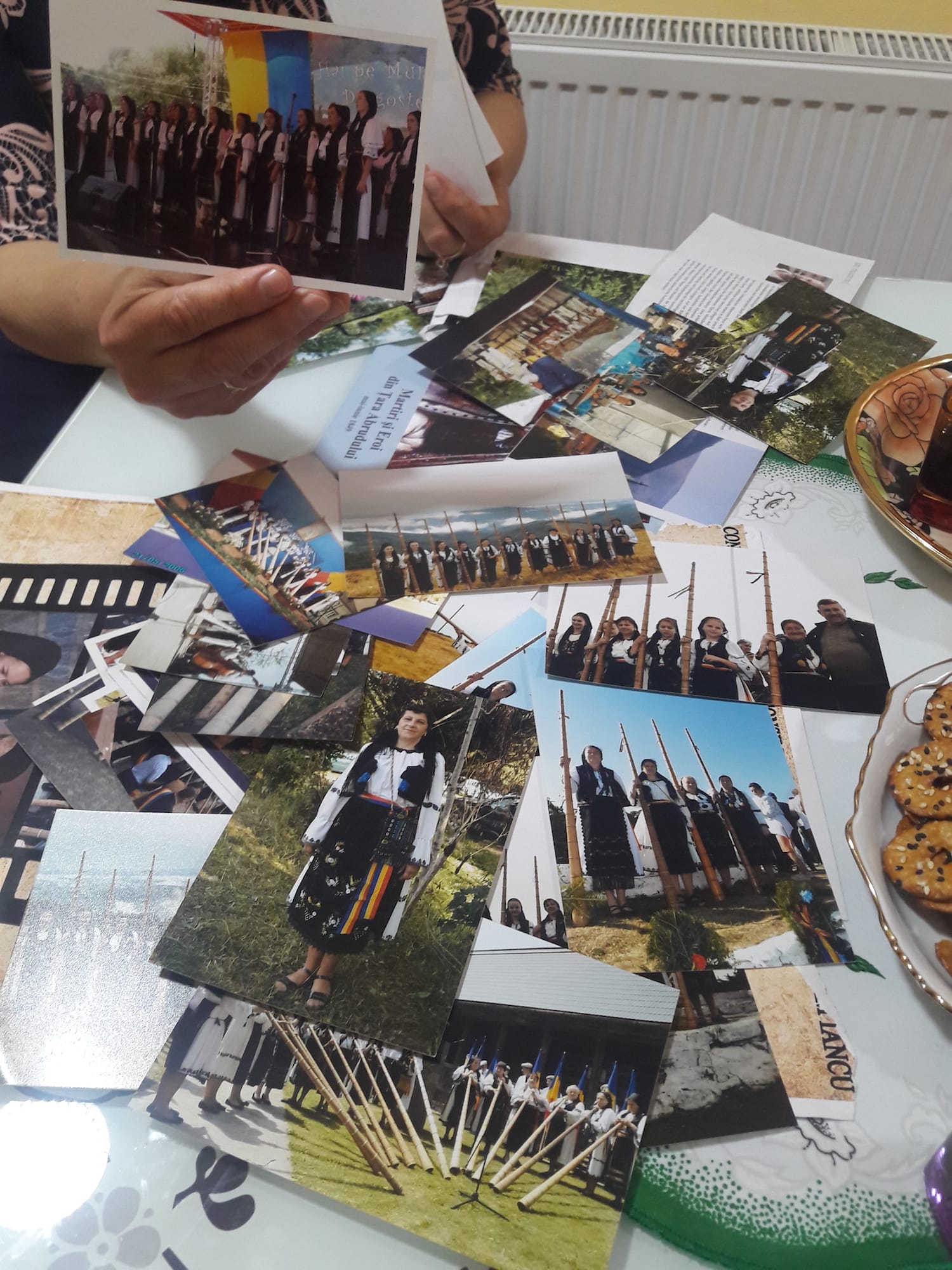
On one of the days I spent in the Apuseni Mountains, I visited Mariana Gligor at her home in Câmpeni (a town located 20 km from Avram Iancu). She is one of the key representatives of tulnic culture at the national level after being recognized by the UNESCO Culture Commission in 2014 as a “Living Human Treasure.” Mariana Gligor formed her group of tulnic players in Câmpeni and has a repertoire of songs slightly different from those in Avram Iancu; the structure, aesthetics, performance style, and cultural meaning are all different. She has incorporated influences from several geographical areas and created her style and repertoire of songs, with a more modern aesthetic but religious cultural meanings. “In Vidra, there were certain melodies, and in Neagra, there were others. I learned both the Vidra and Neagra songs. When I went to Neagra, I played the Vidra songs, and when I went to Vidra, I played the Neagra ones.” She suggests that the role of tulnic players was somewhat imposed on women by society. “If a girl didn’t know how to play the tulnic, she wasn’t considered good for marriage, she was considered dumb. The more capable girls knew how to sew, weave, make pies, and play.” One of her fondest memories remains the social gatherings, during which some games involved reversals of gender roles, especially among unmarried individuals. During these intimate events, young men and women got to know each other, and social relationships, and sometimes even marriages, were formed through these social games.
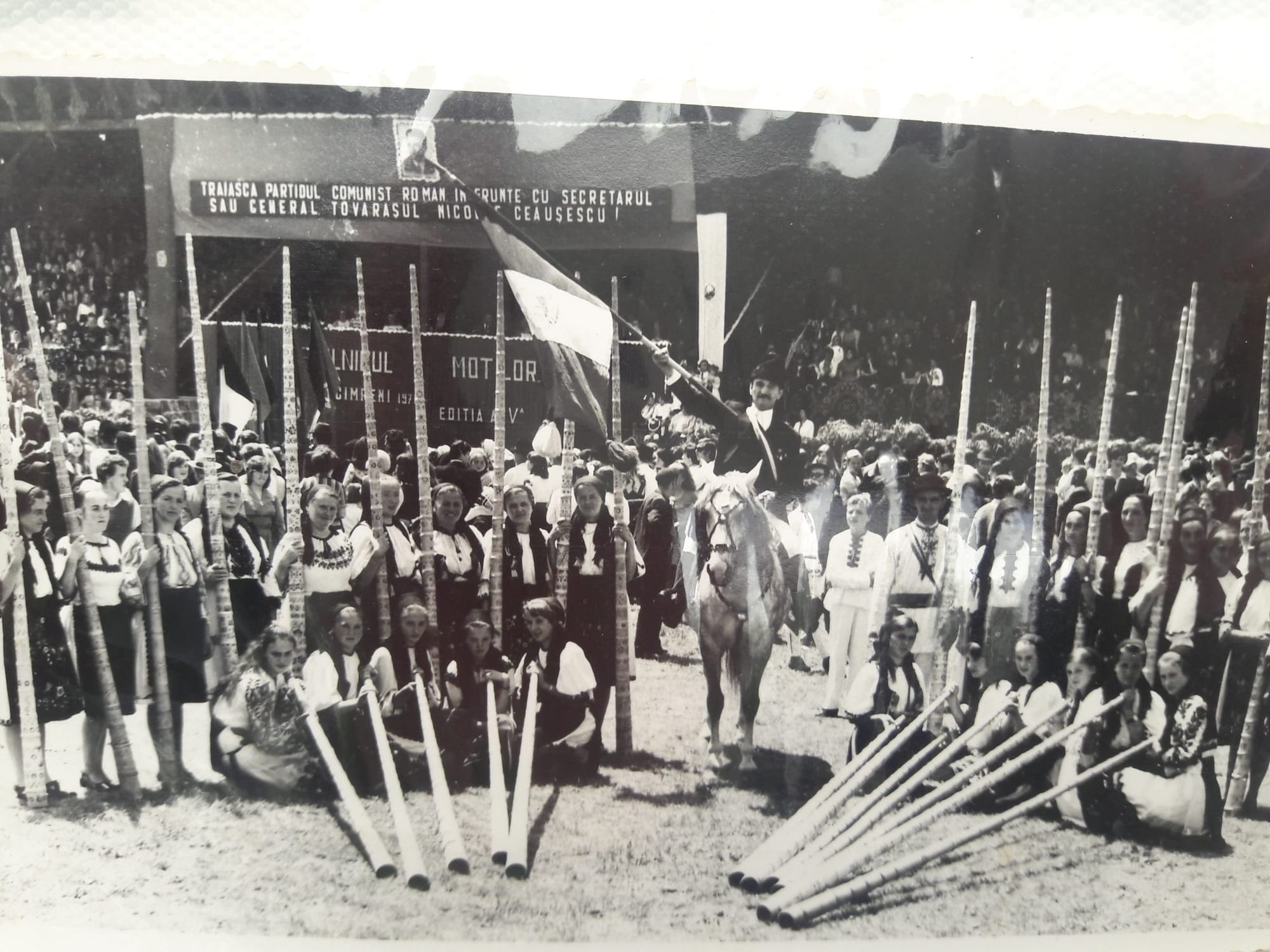
Since she was nationally recognized by UNESCO and has benefited from the support of local authorities, the county council, and the Cultural Center of Alba Iulia, Mariana Gligor is perceived as different by the tulnic players from Avram Iancu. A closer look at the discourse from both sides (the Avram Iancu and Câmpeni communities) suggests the presence of reciprocal, though tacit, tensions. The tulnic players from Avram Iancu tell me that in Câmpeni, “they do playback” during shows and play along with a recording. The virtuosity of playing the tulnic has been replaced with mere commercial performance, driven by the need for spectacle, where “it’s all about image and show.” Performers need to be young and “look good on stage” in traditional costumes.
Gender roles are also evident within the village church. Built on a hill with a capacity of about 200 people, the church was constructed in 1792 from brick and stone in Byzantine style, in the shape of a ship, and is divided into an altar, nave, narthex, and porch. It has two entrances, one for men and one for women. No one knows exactly who or why this was decided; the women in the village tell me that “this was the way things were ordered. A woman is a woman, and a man is a man.” I’ve noticed that during services, men stand in the nave, while women are in the narthex. On the porch, where the singing happens, the choir is made up of men, women, and children.
Since she was nationally recognized by UNESCO and has benefited from the support of local authorities, the county council, and the Cultural Center of Alba Iulia, Mariana Gligor is perceived as different by the tulnic players from Avram Iancu. A closer look at the discourse from both sides (the Avram Iancu and Câmpeni communities) suggests the presence of reciprocal, though tacit, tensions. The tulnic players from Avram Iancu tell me that in Câmpeni, “they do playback” during shows and play along with a recording. The virtuosity of playing the tulnic has been replaced with mere commercial performance, driven by the need for spectacle, where “it’s all about image and show.” Performers need to be young and “look good on stage” in traditional costumes.
Gender roles are also evident within the village church. Built on a hill with a capacity of about 200 people, the church was constructed in 1792 from brick and stone in Byzantine style, in the shape of a ship, and is divided into an altar, nave, narthex, and porch. It has two entrances, one for men and one for women. No one knows exactly who or why this was decided; the women in the village tell me that “this was the way things were ordered. A woman is a woman, and a man is a man.” I’ve noticed that during services, men stand in the nave, while women are in the narthex. On the porch, where the singing happens, the choir is made up of men, women, and children.
Marriages in Apuseni mountains
The profession of tulnic player grants women a certain status in the community and a degree of independence. However, this independence varies depending on the “indulgence” of their husbands. Not all women were lucky enough to be married to understanding men who would allow them to perform with the group when they had scheduled performances, says Maria Coroiu. However, depending on the families they came from, women could be independent enough to refuse an imposed marriage. In the past, after marriage, a wife traditionally became dependent on her husband, and fate “showed the girl whether the choice was good or bad”; nowadays, marriage no longer holds the same power. “Today, weddings aren’t an issue. Even in the village, marriages are made and undone quickly.” Nonetheless, from discussions with the tulnic players, it becomes clear that they have their independence and agency, which, when analysed within a patriarchal context, overturn the dynamics between men and women.
The Girls’ Fair on Mount Găina has been and continues to be one of the most important events in the lives of communities from Apuseni, and over time it has grown in significance, as it became a gathering place for people from several neighbouring counties of the mountain: Arad, Alba, Bihor, and Hunedoara. Here, craftsmen would come to showcase and sell tubs, tulnics, and other tools. Young men and women would gather here and play the tulnic, but there were also folk dance competitions and circle dances. Traditional songs were performed, and animals, food products, and traditional costumes were bought and sold. Ethnologist Florea Florescu says that this fair “is the product of certain social conditions” and was created out of the need for knowledge and communication, kinship, and entertainment.
Although today the name of this fair is problematic, Aurora Pogan Ilie insists that it’s just a legend that “girls were ever sold at the Găina Fair.” Stories claiming that girls used to bring their dowries up the mountain on horses to be betrothed are just myths. “I don’t believe girls were ever traded here because, in Țara Moților, marriages, especially when it came to the girl leaving for another village, were based on love. Moț girls were not sold, there is no indication of that.” Therefore, even though many girls were courted during the fair, few left the village.

Professor Elena Pogan says in an interview that the name “Târgul de fete” (Girls’ Fair) appeared relatively recently, and most likely, the name was given to the fair by men. Although young people would meet there, and girls were courted by suitors with their parents’ consent: “It wasn’t a girls’ fair, it was a market for exchanging goods and saying goodbye until next year. I would very much like it if it was no longer called the girls’ fair; they should call it Târgul Găinii (Găina Fair), just as it was named since it was established.”

Historically, folklorism has captured the tulnic and engaged it in nationalist discourse, and questioning classical dichotomies such as traditional/contemporary comes with a series of risks and opportunities. The risks involve the perpetuation of certain cultural practices inspired by colonial, hegemonic, and cultural appropriation dynamics, in which an entity at the centre (thus in a position of power) accesses, borrows and transforms at will and to its interest certain cultural traits of an entity at the periphery. Since the centre cannot exist without the periphery, these risks can turn into opportunities when power dynamics are overturned through a process of translation and decentralization.
Lead image by Dragoș Rusu.
This article is brought to you by Easterndaze, as part of the EM GUIDE project – an initiative dedicated to empowering independent music magazines and strengthen the underground music scene in Europe. Read more about the project at emgui.de.
Funded by the European Union. Views and opinions expressed are, however, those of the author(s) only and do not necessarily reflect those of the European Union (EU) or the European Education and Culture Executive Agency (EACEA). Neither the EU nor EACEA can be held responsible for them.


